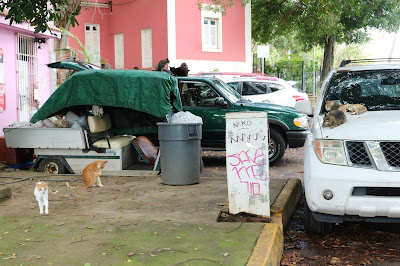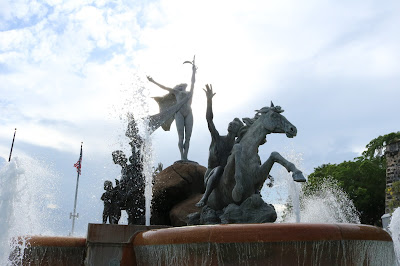An Afternoon in Old San Juan
After our visit to El Yunque, we made our way to Old San Juan. We had no real idea what to expect there, nor any real plan of attack. We just found parking and started walking. The first order of business was to find something to eat. We came upon a nice bar/restaurant and had an enjoyable meal there.
After we finished eating, we just went wandering. We figured we would just walk in the general direction of one of the forts and see what we could find.
San Juan is the oldest city in the U.S. and its territories. It was founded in 1521. Actually, when Columbus stumbled first upon the island in 1493, he named it San Juan Bautista and the port city was Puerto Rico, which means rich port. But a cartographer got a bit confused when he was drawing a map in the of the island in the 1520s and he swapped the names. No one bothered to switch them back and San Juan grew to become an important Spanish colonial city with a hospital and university.
The city is awash in colorful buildings.
Old San Juan's blue cobblestone streets are made of adoquine, a blue stone cast from furnace slag. The stone was used as ballast for the ships that came to the Caribbean empty in anticipation of returning laden with such goodies as sugar.
How's that for a seaside cemetery? This is the Santa Maria Magdalena de Pazzis Cemetery, which dates back to 1814.
And this is Castillo San Felipe del Morro. It was built between 1539 and 1790 as a defense against pirates and other antagonists hoping to seize San Juan from the Spanish. The tall building is the El Morro Lighthouse, which was rebuilt in 1908 and remains in use today.
This is Raices, which means "roots." It was sculpted in 1992 by a Spanish artist to celebrate the origins of the Puerto Rican people. Their Taino, Spanish, and African roots all blend together and rise out of the ocean escorted by dolphins.
I'm not sure what this building is. It's located next to the piers. I liked its Moorish architecture.
The restaurant's decor was eclectic and fun.
After we finished eating, we just went wandering. We figured we would just walk in the general direction of one of the forts and see what we could find.
San Juan is the oldest city in the U.S. and its territories. It was founded in 1521. Actually, when Columbus stumbled first upon the island in 1493, he named it San Juan Bautista and the port city was Puerto Rico, which means rich port. But a cartographer got a bit confused when he was drawing a map in the of the island in the 1520s and he swapped the names. No one bothered to switch them back and San Juan grew to become an important Spanish colonial city with a hospital and university.
The city is awash in colorful buildings.
Old San Juan's blue cobblestone streets are made of adoquine, a blue stone cast from furnace slag. The stone was used as ballast for the ships that came to the Caribbean empty in anticipation of returning laden with such goodies as sugar.
Something rather important is missing here.
This unusual work of art is a totem pole created in 1992 to commemorate the 500th anniversary of Columbus's "discovery" of the New World. It's forty feet tall and is made of black granite. Supposedly, those are pieces of actual Taino ceramic encrusting it. The Taino were the indigenous people of the Caribbean islands. The totem pole stands in Plaza del Quinto Centenario. Which in English the Quincentennial Square.
One of the two Lambs of God that are also located in the Plaza del Quinto Centenario. This reminded me a lot of the symbol for Steve's home town, Preston.
The other lamb.
And this is Castillo San Felipe del Morro. It was built between 1539 and 1790 as a defense against pirates and other antagonists hoping to seize San Juan from the Spanish. The tall building is the El Morro Lighthouse, which was rebuilt in 1908 and remains in use today.
You see a lot of tsunami signs around the island. The simple notion that such signs are necessary gave me pause. I'm used to hurricane evacuation route signs, not this. This one indicates that El Morro is a safe place to assemble in the event of a tsunami. Some of the signs in Isabela, where Steve lives, don't have such good news.
Old San Juan is a walled city. We couldn't figure out how to get down to the path on the other side of the wall. We followed along the wall as best we could. It afforded us some lovely views.
A bright pink blossom amongst the grass.
I had read about the feral cats of El Morro before we ventured there. It's against the law to touch the cats. An organization called Save the Gatos provides food, water, shelter, and medical car for the hundreds of cats who call the streets of Old San Juan home. The organization also spays and neuters the cats. Here's a quick shot of a small number of the population just hanging around.
This statue is La Rogativa. It's a bronze sculpture crafted in 1971 that depicts the procession in 1797 of the bishop and religious women that is said to have scared off an invading British fleet. Apparently, the British mistook the procession as military reinforcement.
Old San Juan is home to some impressive banyan trees.
This is Raices, which means "roots." It was sculpted in 1992 by a Spanish artist to celebrate the origins of the Puerto Rican people. Their Taino, Spanish, and African roots all blend together and rise out of the ocean escorted by dolphins.
There was nothing to tell us about this beautiful ship. Luckily, there's the internet. This is the Juan Sebastien de Elcano, which is named for the fleet captain of Ferdinand Magellan's final voyage. The Royal Spanish Navy uses her to train its naval cadets. She is a four masted barquentine (aka schooner barque) that was first launched in 1927. She is 370 feet long and has logged over two million nautical miles. She is currently on her 87th training cruise. Her other ports of call during this cruise include Havana, Cuba; Miami, Florida; and Baltimore, Maryland.
I'm not sure what this building is. It's located next to the piers. I liked its Moorish architecture.



































Comments
Post a Comment